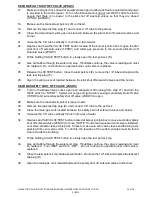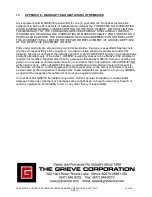
W:\ELECTRICAL\INSTRUCT\FURNACE\FURNACE GENERAL INSTRUCTIONS 2011.DOC
22 of 36
01/2014
7-8.7.3
Inspect to make sure all blowers, exhausters and other fans are rotating in the
correct direction. Refer to Section 4-5 for changing rotation.
7-8.7.4
Periodically inspect and clean blower and exhauster wheels to remove any
build up of deposits on the blade surfaces. Accumulation of deposits could
possibly reduce volume of air flow and cause a dangerous reduction in safety
ventilation.
7-8.7.5
Air flow test should be conducted on the exhaust flow under furnace
operating conditions, with volume controls at their minimum settings, to
ensure that the safety ventilation required is achieved. Reference Safety
Design Form for required ventilating. See Section 8 - TROUBLE SHOOTING
for inadequate ventilation symptoms.
7-8.8 Electric Furnaces
7-8.8.1
Temperature controller should cycle main contactor(s),or SCR power
controller, only. Separate (back-up) contactor(s) should not cycle.
7-8.8.2
All safety switches should open both main contactor(s), or SCR power
controller, and separate (back-up) contactor(s).
7-8.8.3
Inspect heating elements for contamination, distortion and adequate support.
7-8.8.4
Check electrical heating element connections at terminals for tightness.
7-8.9 Fuel Gas Furnaces
7-8.9.1
Check main safety shut off valves for leakage. (See Appendix D - Main Safety
Shutoff Valve Leak Test Procedure)
7-7.9.2
Check pilot safety shut off valves for leakage. (See Appendix D - Pilot Safety
Shutoff Valve Leak Test Procedure)
7-8-9.3
Check that vent valve is closed when main burner is firing. (Note: Vent valve
is only installed by specific request of customer.)
7-8.9.4
With pilot burner lit, check low gas pressure switch setting by turning gas
pressure switch setting up until pilot is shutdown. Reset to original setting as
indicated on electrical wiring diagram.
7-8.9.5
With main burner firing, check high gas pressure switch by turning gas
pressure switch setting down until burner is shutdown. Reset to original
setting as indicated on electrical wiring diagram.
7-8.9.6
Lubricate gas cocks and operate to confirm free movement.
7-8.9.7
Locate remote emergency valve, lubricate and operate to confirm free
movement.
7-8.9.8
Safety valves should be replaced when the number of safety valve cycles
reaches 90% of lifetime cycle rating. Number of cycles can be estimated by
multiplying years of service by 260 work days per year (5 day work week) and
the number of times furnace is turned on and off per day. Lifetime cycle
rating for valves is at least 1 million cycles. Replace valves if estimated
number of cycles exceeds 900,000.















































